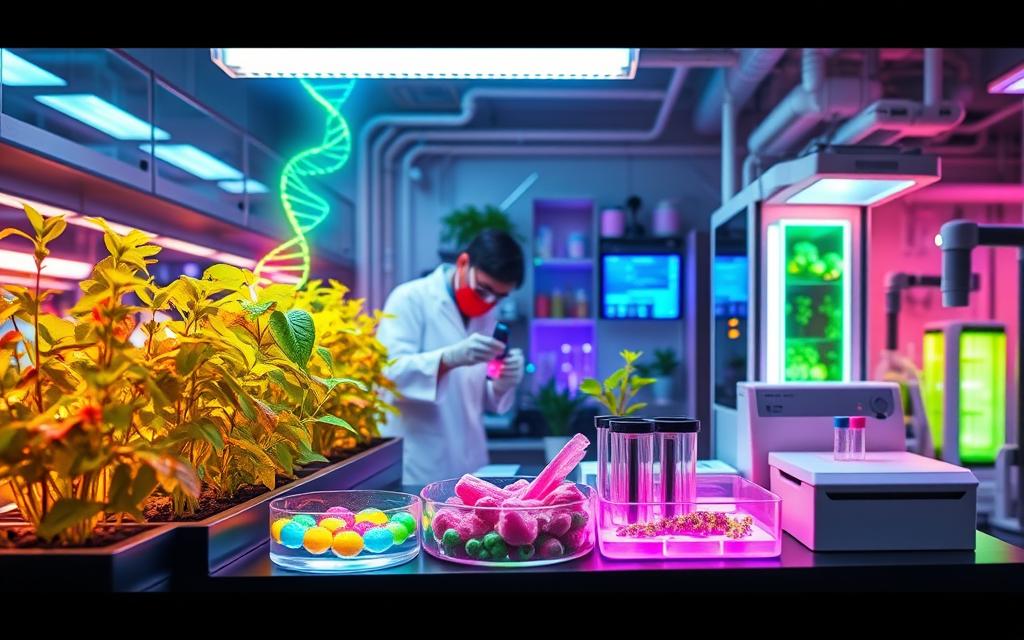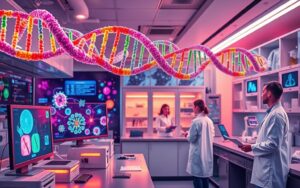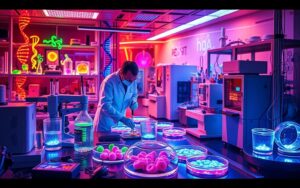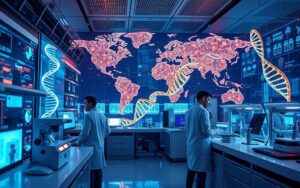Applications of Recombinant DNA Technology
Since the 1970s, recombinant DNA technology has changed biotechnology. It started with Werner Arber’s discovery of restriction enzymes in 1968. This method lets us mix genetic material from different organisms. It leads to many uses in medicine, farming, food production, and fixing environmental problems.
In health care, recombinant DNA plays a key role in making medicines and tools for detecting diseases, like HIV. It’s also crucial in gene therapy, offering new treatments for diseases such as leukaemia and sickle cell anaemia.
In farming, this technology has made GMOs like Flavr Savr tomatoes and golden rice. These GMOs help crops last longer and fight off pests and diseases. This is great for food supply and sustainability.
Recombinant DNA technology also helps in food industries and environmental care. It uses engineered microorganisms to clean up pollution, like oil spills. This marks a new chapter in how we tackle global challenges through science.
Introduction to Recombinant DNA Technology
Recombinant DNA technology is a groundbreaking field in biotech. It aims to alter genetic material to get specific traits. It does this by adding targeted genes into new carriers or vectors. The idea started in the 1970s with experts like Paul Berg. They showed we could splice and recombine genes.
The core of overview of recombinant DNA technology is about extracting and changing DNA sequences. First, you isolate the DNA. Then you cut it with restriction enzymes. After that, you join these pieces into vectors. Finally, you add the recombinant DNA into host organisms. This leads to big steps forward in genetic editing.
Studies highlight recombinant DNA technology’s huge potential. It can tackle health issues, improve food security, and solve environmental problems. By 2001, over 80 products based on this technology were approved. They were for treating diseases and for vaccines. Many more are being tested. This technology is used in making transgenic animals and pest-resistant crops. Examples include Bt-cotton and golden rice.
Moreover, this technology is key in modern medicine. It helps make important drugs like insulin and human growth hormone. It also offers therapies for conditions that could benefit from gene therapy. Gene cloning techniques let scientists improve the genomes of organisms. This opens new doors in agriculture and healthcare.
Thanks to extensive research and progress, recombinant DNA technology keeps transforming our understanding of genetics. It provides tools for major breakthroughs in several fields.
How is Recombinant DNA Technology Used in Medicine?
Recombinant DNA technology is key in modern medicine, helping to fight diseases and better patient care. It helps create new drugs, gene therapy, and better tools for diagnosis.
Development of Recombinant Pharmaceuticals
In medicine’s biotechnology, recombinant pharmaceuticals have made big leaps. Now, we can make vital proteins like insulin in labs using genetically changed organisms. This is crucial for tackling diabetes and many cancers. The FDA has approved many such drugs, especially for genetic disorders. This shows how vital these breakthroughs are.
Gene Therapy and Its Implications
Gene therapy changes the game by fixing genetic issues with new, healthy genes. It’s starting to help with diseases like muscular dystrophy. By using viruses to carry genes into cells, lasting treatments might now be possible. This could change how we treat long-term conditions, giving many new hope.
Diagnostic Tools and Techniques
Thanks to this technology, we’ve got better ways to diagnose diseases. With PCR, we can find and study bits of DNA from illnesses, making diagnoses faster and more accurate. It’s key for spotting HIV, COVID-19, and checking for genetic issues. This fast genetic analysis is making a big difference in healthcare.
Looking more into recombinant DNA technology in medicine shows its big impact. It’s changing how we develop treatments and diagnostic ways, reshaping healthcare entirely.
Applications of Recombinant DNA Technology in Agriculture
Recombinant DNA technology has hugely changed farming, making it more advanced and sustainable. Genetically modified organisms (GMOs) have brought new traits to crops. Traits like pest resistance, handling dry conditions better, and more nutrients help tackle climate and population challenges.
Genetically Modified Organisms (GMOs)
GMOs are key in modern farming biotech. By using recombinant DNA methods, scientists make crops that produce more food and are more sustainable. Crops like Bt cotton and Roundup Ready© soybeans resist pests and herbicides. These GM crops cut down on chemicals needed and make it through tough weather better. They even have higher nutrients, like Golden Rice, which helps reduce vitamin A deficiency.
Enhanced Crop Resistance and Yield
DNA markers have boosted biotech’s effect on improving crops. Tools like PCR and SNP markers watch genetic traits in crop development closely. These markers help in many ways:
- They tell cultivars apart through seed purity tests.
- Understanding genetic diversity keeps crop resources safe.
- They make breeding easier by predicting hybrid vigour.
Transgenic crops are doing wonders, helping about 5.5 million farmers over 148 million acres globally. Thanks to GM crops, production’s up and chemical use is down. This shift leads to farming that’s better for the planet.
| Crop Type | Trait | Benefit |
|---|---|---|
| Bt Cotton | Pest-resistant | Reduced chemical pesticide use |
| Roundup Ready© Soybeans | Herbicide resistance | Effective weed control |
| Golden Rice | High in beta-carotene | Combats vitamin A deficiency |
| AquAdvantage Salmon | Fast growth rate | Reach market size quicker |
In short, recombinant DNA technology is a big help in making crops better and farming more sustainable. By solving major farming issues, GMOs are crucial for our future food supply and the planet.
Recombinant DNA Technology in the Food Industry
Recombinant DNA technology is crucial in the food industry. It boosts production efficiency and betters product safety. It lets us make genetically modified foods that people want and that fix nutritional issues. This section looks at how this tech helps food production and food additives get better.
Production of Genetically Modified Foods
Genetically modified foods have changed food biotechnology. Thanks to recombinant DNA technology, we now have Bt corn and Golden Rice. Bt corn fights off pests, and Golden Rice aims to stop Vitamin A deficiency, especially where rice is a main food. These breakthroughs help make food more secure and safe worldwide.
Improvement of Enzymes and Additives
Developing food enzymes and additives relies heavily on recombinant DNA technology. For example, creating chymosin for cheese making. This method makes sure the enzyme is always high quality and vegetarian-friendly. It not only makes food tastier and better textured but also cuts down on waste. This promotes sustainability and food safety by battling pathogens.
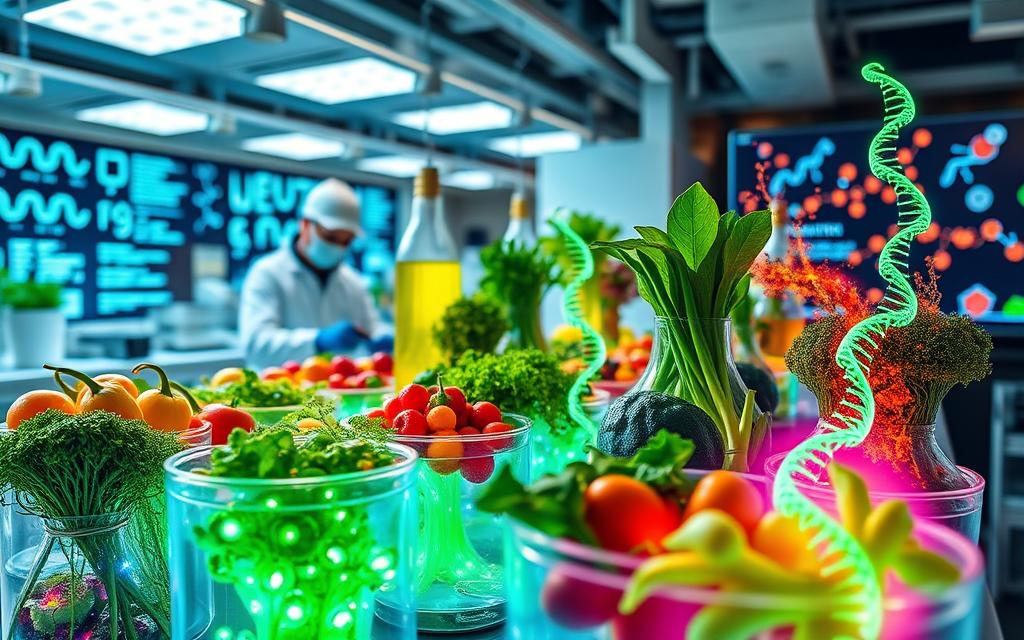
| Genetically Modified Foods | Benefits |
|---|---|
| Golden Rice | Combats Vitamin A deficiency |
| Bt Corn | Built-in insect resistance |
| High-Fructose Corn Syrup | Sweetener production efficiency |
| Chymosin | Vegetarian cheese production |
Recombinant DNA technology is key to enhancing food production while keeping safety first. This leads to a better food supply. Such progress mixes science and food production well, setting the stage for more breakthroughs.
Environmental Applications of Recombinant DNA Technology
Recombinant DNA technology is key in fighting pollution and managing waste through environmental biotechnology. Scientists use this technology to create new solutions. These help fight environmental harm, enhance the balance of ecosystems, and keep the environment healthy.
Bioremediation Strategies
Bioremediation uses special microorganisms to clean up pollutants. These microorganisms can break down dangerous substances like oil spill hydrocarbons and heavy metals in the soil. This process cleans pollution and is better for the environment than old methods.
More people are now interested in microbial genetic engineering because bioremediation works well. Scientists modify microorganisms to make them better at cleaning the environment. They also research how these microorganisms can improve wastewater treatment by acting as bioflocculants. As the need for water reuse grows, finding the right microorganisms for this job is crucial.
Genetic Engineering of Microorganisms
Changing the genes of microorganisms is a big step forward in solving environmental problems. Recombinant DNA technology lets scientists create microorganisms that break down industrial toxins or find pollutants. This shows how versatile and effective these microorganisms are in protecting the environment.
Keeping up the research is crucial. As recombinant DNA technology advances, it will bring new ways to fight pollution and manage waste. These developments are important for combining environmental biotechnology with traditional waste management. This integration leads to a more sustainable future. Read more about how it works at how DNA technology functions and its.
Conclusion
Recombinant DNA technology has changed medicine, agriculture, and environmental science. It has introduced over 80 products for treating diseases and vaccinating since 2001. With 350 more products being tested, it shows how fast biotech is growing. This technology could change healthcare and food production greatly.
But, as this technology grows, we must think about its ethical impacts. We need to consider how genetic changes affect biodiversity, food safety, and health. Looking back, we learn the importance of ethics in innovation. People like Paul Berg and Daniel Nathans made big strides with ethical standards in mind.
The future of recombinant DNA technology is bright. It could solve big global challenges. By focusing on ethics and pushing scientific discoveries, we can make sure future use of this technology is responsible and effective. This way, we’re heading towards a healthier, sustainable world for everyone.
FAQ
What is recombinant DNA technology?
Recombinant DNA technology allows us to mix genetic material from different organisms. This creates new genetic sequences. It changes DNA outside of an organism. It also lets us add specific traits into other carriers or vectors.
How has recombinant DNA technology impacted medicine?
It has changed the way we make medicines. We can now produce important proteins, like insulin. It also helps with gene therapy for genetic issues and makes better diagnostic tools.
What role does recombinant DNA play in agriculture?
It is key in making GMOs with traits like pest resistance. This helps crops survive better, yield more, and supports feeding more people globally.
What are the ethical considerations surrounding recombinant DNA technology?
We worry about losing biodiversity, environmental and health risks. As we use this technology, we must consider ethical standards. This helps ensure it benefits future generations properly.
How does recombinant DNA technology contribute to environmental health?
It is used in bioremediation where modified microorganisms break down pollutants. This technology helps clean pollution and take care of environmental challenges.
Can you explain gene therapy?
Gene therapy uses this technology to swap bad genes with good ones to treat genetic diseases. This uses techniques like viral vectors to deliver these genes and tackle diseases we couldn’t before.
What are the applications of recombinant DNA technology in the food industry?
It’s used in making genetically modified foods with better nutrition and safety. Also, it creates enzymes that enhance how we process and keep food fresh.
